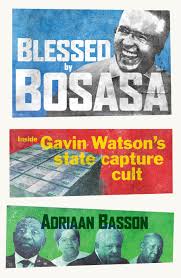
Adriaan Basson, Blessed by Bosasa: Inside Gavin Watson’s State Capture Cult (Johannesburg: Jonathan Ball)
THE GRAND corruption of Gavin Watson’s facilities management company, Bosasa, detailed at length in Adriaan Basson’s book will be familiar to anyone who has followed the Inquiry into State Capture conducted by Raymond Zondo. Basson’s account raises two most uncomfortable issues. First, state capture, is indigenous not just the opportunism of foreign criminals intent on suborning a venal president, and it is now deeply embedded in South African political culture. Second, the perpetrators are sometimes struggle-era activists: in Basson’s blunt terms, freedom fighters turned parasites; with greed, blind loyalty and fear trashing the rule of law.
The four Watson brothers were well-known in the eastern Cape for their brave support of non-racial rugby. The family clothing business was exempt from the consumer boycott and two of the brothers were very close to the ANC. Suspected arson of the family house was attributed to the state dirty tricks department even after Valence was convicted of insurance fraud. There was a significant dissenting voice, that of Mkhuseli Jack, who always regarded the Watsons as controlling business people whose first loyalty was to family. It was a highly prescient view.
After liberation the clothing business floundered, but Gavin, the eldest and least political of the brothers, became involved in a supposed black empowerment initiative with the ANC Women’s League and a facilities management company renamed Dyambu (sun). In questionable fashion through a front company called Consilium it soon fell under the sole control of Watson, who surrounded the firm with an opaque ownership structure. His manipulative tendencies were to become legendary and he consistently managed to avoid appending his signature to documents. Involvement with the notorious Lindelani detention centre and a youth hostel provided access to catering at Department of Correctional Services prisons. Other contracts were to involve fencing, access control and televisions. The R26 000 unit price of the last signifies explicit corruption; and with time Bosasa basically stole, and then ran, a government department, one that was ‘deeply troubled and depraved’. National commissioner Vernie Petersen, who was first obstructed then hounded out of the department, described it as the most corrupt of all government entities.
Its staff fought tenaciously to preserve this outrageous relationship based on payments in cash and kind (cars and handbags were highly favoured) to politicians and public servants. Others (the name of Schreiner appears) turned a blind eye while a few, at their peril, opposed the system. Basson suggests that intelligence connections (such as Gibson Njenje) were used to suppress whistleblowing and the rumour was put about that temporarily released prisoners were available for dirty work. As with other instances of corruption, the manipulation was extraordinarily blatant: for instance, catering providers were required to provide security as well. Bosasa got away with this because it drafted the tenders, which then evaded all the normal legal processes. Their renewal was well lubricated by bribery. The new rottenness of old eastern Cape struggle links was personified by minister Ngconde Balfour.
When there was exposure in the press in 2009, Watson comprehensively destroyed evidence. After a fake server crash, documents and hardware were atomised on a construction site and material was flushed down toilets. Nemesis arrived only after long-time loyalists like Angelo Agrizzi decided to blow the whistle, but for years Bosasa was kept out of court by corrupt prosecutors linked to the Zupta faction. Watson made no attempt to hide his links with Jacob Zuma and allies like Nomvula Mokonyane.
Bosasa was more cult than company. Watson ruled it through religion, fear and money. Tenders, all of which involved bribery, were anointed with oil and there were morning prayers (the Watsons’ father was a preacher), some form of communion and occasional all-night vigils. To complete this strange picture of a Christian company’s engagement in bribery, illegality and deception there was a mistress, Lindie Gouws. She reinforced the cult by describing Watson as the ‘anointed one’. When asked about the denominational origin of Bosasa’s religious activity, he replied ‘I am the church’: ritual and deification were employed to pursue enrichment. At one point Basson questions Watson’s mental state with the ability to ‘switch between Christian morality and naked depravity’ and concludes that he was narcissistic and paranoid and managed by disparagement and bullying.
He undoubtedly knew how to exploit human weakness. The current state of chronic capture in South Africa is explained by the manner of the bribery: recurrent payments that encourage a comfortable lifestyle and engage ongoing co-operation. Gavin’s vault, a cavern of cash that effectively monopolised tenders, will be an enduring image of the Zondo commission alongside Agrizzi’s little black book. It is only the most egregious examples of corruption that now excite attention, so normal is the practice within the ruling party as the ANC likes to describe itself. But it goes beyond this as Basson explains: larceny so widespread would not be possible without the complicity of banks, auditors and lawyers. The repercussions thus far have been minimal for both the blessers and the blessed who benefit so richly from purloined public money.